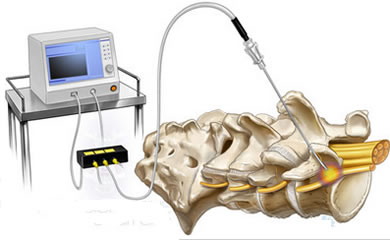Facet denervation through rhizolysis

Summary
Lumbar percutaneous facet denervation is a minimally invasive technique which provides a fast improvement of lumbar pain and allows patients to restart their daily activity quickly. Its use does not restrict posterior surgery, but it can avoid surgery in a high percentage of patients with motivation to follow a muscle reeducation and strengthening program.
What is percutaneous facet denervation?
Facet Syndrome is the pain produced in the facet joints located at the lumbar área and tissues around it.
Lumbar percutaneous radiofrequency facet denervation is a surgical minimally invasive technique appropiate for symptomatic treatment of chronic lumbar pain of facetary origin. It´s applicable to posterior joints pain conditions which have not responded to conservative treatments.
How is it performed?
In this radiofrequency treatment, the prostrate patient is monitored by a digital radioscopy system (X Ray) which allows doctors to see the spine in detail throughout the process. Rhizolysis applies an electrical current on the nerve which transmit sensitivity thanks to one electrode, what makes that nerves get thermocoagulated, alleviating pain.
Roots of, at least, two segments must be removed, and two or three damages need to be made in each root, as there are individual variations in its pathway.
Application cases
 Rhizolysis is effective in chronic patients affected by vertebral facet joints injuries. In some cases, it may be that, although a facet joint nerve has been destroyed, since this facet joint recieves nerves from two or even three vertebral levels, patient´s pain doesn´t go away, or it does, but only temporarily.
Rhizolysis is effective in chronic patients affected by vertebral facet joints injuries. In some cases, it may be that, although a facet joint nerve has been destroyed, since this facet joint recieves nerves from two or even three vertebral levels, patient´s pain doesn´t go away, or it does, but only temporarily.
In this treatment nerves don´t regenerate, as the objective is to destroy them, what can cause long-term problems and even not being effective on pain remission in some cases, although they are the rarest cases.
Benefits
- No surgery needed.
- No hospitalization needed.
- Life quality improvement thanks to pain relief.
- It helps to localize the pain zone precisely.
- 80% of patients improve.
Possible risks
- Temporary pain increase.
- Medicines reactions, such as sudden heat or rash.
- Infection at the injection place.
- Hematoma, if accidentally there´s any damaged blood vessel.
- Nerves damaged at the injection place.


